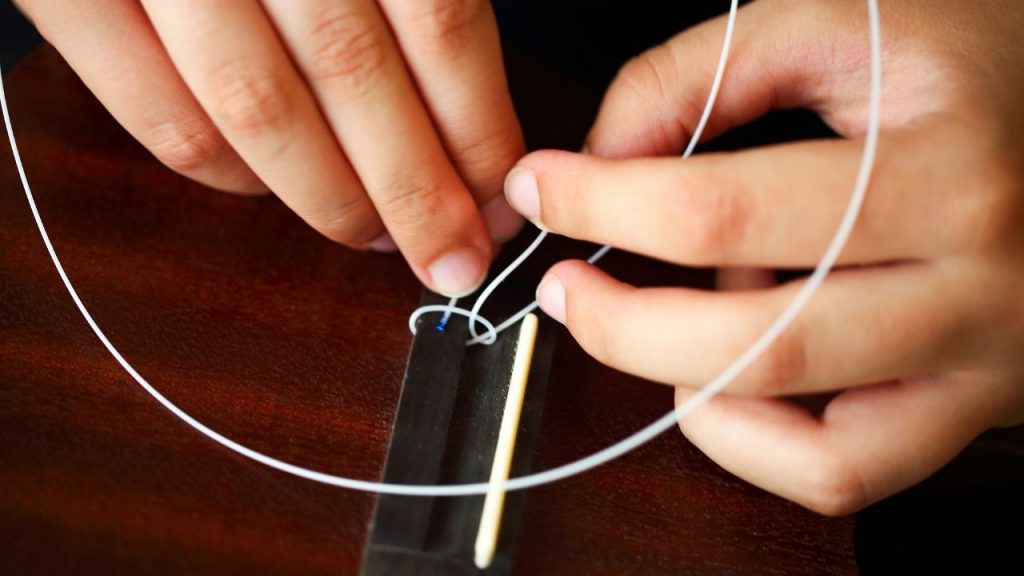Replacing uke strings may seem pretty straightforward – you unwind the pegs, insert the replacements, and you’re done. But, this yearly uke maintenance requires more attention and precision. Here’s how to string a ukulele – the right way.
Change Your Uke Strings in 6 Easy Steps
You don’t have to change ukulele strings every week or monthly. But, once your uke’s strings show signs of wear like nicks, flat spots, and grooves, it’s imperative to change the strings stat! Don’t worry, though. Changing the strings is an easy process that anyone can master.
1. Get the Correct Uke Strings
The first step in stringing a ukulele is to make sure that you have the right set of strings for your ukulele. This is because some uke strings are more suitable for a particular uke type. For instance, if you have a baritone ukulele, you should look for a string set with DGBE tuning. Plus, it would be best if you also considered your strumming style and the string tension and scale length.
The ukulele string sizes are as follows:
- Soprano 21 inches long 13-inch scale length
- Concert 23 inches long 15-inch scale length
- Tenor 26 inches long 17-inch scale length
- Baritone 30 inches long 19-inch scale length
Pro Tip: When you want to get new strings for your ukulele, you should always choose the type that befits your level. Cheap strings would be better if you are a beginner, although they break easily.
2. Unwind the Old Strings
Unwinding the uke strings differs depending on the location of the tuning pegs. Some tuning pegs are at the side, while others face backward.
For those on the side, you need to begin with turning the two pegs that face upward clockwise. Then, turn the other pegs facing downward counter-clockwise. Once the string is loose enough, you can remove it from the peg.
Slotted ukuleles require you to unwind the string enough to either push it through the hole or cut it with a pair of scissors. If you have a standard bridge, slide the string off by gently pulling the peg to free it. A tie bar bridge requires you to untie the knot at the end of the string.
Pro Tip: If you are unsure which direction to turn, you can pluck the string while turning the peg. If you pluck the string and it produces a brighter sound, you’re not turning the peg in the right direction.
3. Clean the Uke

Cleaning your instrument is an integral part of the process of learning how to change your ukulele strings.
Once you have successfully removed the strings, the fingerboard becomes fully accessible. This is when you will notice that plenty of grime accumulates on the surface, especially for a uke used regularly.
Take this opportunity to clean your instrument using wood polish, lemon oil, or a special ukulele cleaner. This ukulele cleaner is a complete kit that uses 100% natural oils to clean and protect your uke. Use a soft and lint-free cloth to clean the dirt in all places, including the bridge.
4. Attach the New Strings

When restringing your uke, you should always begin with the C string. This is because higher strings are harder to tune due to their thinness. Plus, they are prone to breaking easily, especially when you opt for a metal one. The E, A, and G-strings should follow, respectively.
Pro Tip: If you want to learn how to string a ukulele, then one string at a time is the way to go.
If your uke has a pegged bridge, you should tie a knot at the end of the string. This is to keep it from slipping through the peg. Then, press the peg over the knot. You can tie a double knot if it keeps getting undone.
A tie bar bridge ukulele requires you to insert up to three inches of the string into the bridge hole and pull. Then:
- Make a knot on it and pull the shorter end
- Loop it once more, then tighten to secure it.
- Insert the end of each string to a corresponding peg.
- Loop it once over and twice underneath
- Then, tighten the string.
5. Tighten the Strings
Tightening your ukulele depends on the position of the pegs, as mentioned earlier. If they are on the side like a guitar, you should turn the top ones counter-clockwise. For lower pegs, you should move them clockwise.
Tighten just enough to achieve tension that will allow the tuner to bring them to the right tone. New strings often require adjustment to keep them in the right tune. With time, they will stretch and can maintain the proper tune for an extended time.
6. Use a Tuner

Ukulele tuning for tenor, soprano, and concert players typically use the G-C-E-A approach. The tuning method is called reentrant tuning, where strings do not follow the lowest to the highest pitch sequence. The third string produces the lowest pitch. Tightening and loosening the ukulele strings is done by turning the tuning pegs on its headstock.
There are various methods you can use to achieve the right tune. These include pedal tuners, clip-on digital tuners, and smartphone tuning apps. Pedal tuners can only be used by ukuleles that have an electronic pickup. On the other hand, clip-on tuners attach to the headstock to measure vibrations in the instrument’s wood. You can also use a smartphone ukulele tuning app but it can be inaccurate.
Uke Strings FAQ
Can You Reuse Old Ukulele Strings?
You shouldn’t reuse old ukulele strings. Worn-down or overused strings are more prone to snapping or breaking, especially for higher strings. So, unless you want your face to get hit with a nylon strong (or worst metal string), we don’t suggest reusing old ukulele strings.
How Long Should Ukulele Strings Last?
Ukulele strings can last anywhere between eight months to one year. However, this is just an estimate; the lifespan of uke strings depends on how often you play your instrument. You can determine the time by noting how long it took for you to need a new set.
How Do I Know if My Ukulele Needs New Strings?
When the interval between tuning becomes frequent, it is a sign that the strings are worn out. You need to check if they have grooves, flat spots, or nicks, too, as this might cause them to break at any time.
Conclusion
Now that you know how to string a ukulele, you must understand that the new strings will take time to produce the desirable tune. The various tuners we have mentioned will help you along the way. You can also try stretching the strings using your finger to get them to be compliant.
Table of Contents






